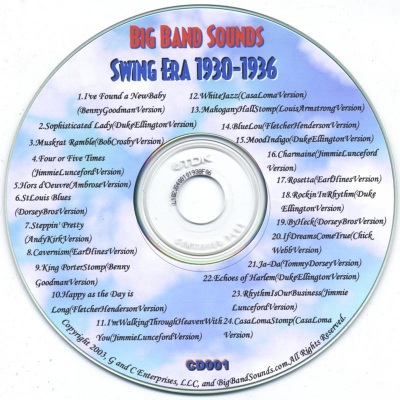
Swing Era 1930-1936 - Cd001
The seeds of swing, sown in the late 1920s, began to sprout in the early 1930's. By 1926 Fletcher Henderson had put together a big jazz band and subjected it to the discipline of written arrangements so that whole sections swung like soloists. Duke Ellington and other black bands soon got the idea. White bands did not, though several tried. Some even bought Henderson band arrangements only to find that their sidemen simply could not play them. Ben Pollack, Jean Goldkette and, at times, Paul Whiteman, featured top jazzmen and some swing arrangements, but Casa Loma was the first white band to adapt to the new style with any success and continuity in person, on records and on the air. The band depended more on the expertise of its sections rather than on individual stars. More than 2/3 of the numbers in this 1930-1936 album were originally played or arranged by black musicians. The music of the period is swing with a sound and style somewhat different from later years. Tempos are bouncier, orchestrations sparser, the whole effect more angular. Bands still included instrumental holdovers of older jazz days. In many of these musical numbers the banjo and tuba could be heard. But banjoists were learning to play the more flexible guitar, and tuba players had to double on the string bass if they wanted to hold their jobs. Many of the later swing heroes were still itinerant sidemen, playing in pick-up groups, getting stranded on one-night stands, wondering where their next job or meal or drink was coming from. But in 1934, the Dorsey Brothers organized their big band, and it started to swing. Benny Goodman was shaping a group to his own high standards of perfection and shrewdly getting men like Fletcher Henderson to do arrangements for him. Black bands were peaking both in performance and popularity. The sounds were bigger and better. Suddenly, the Swing Era burst into being.
